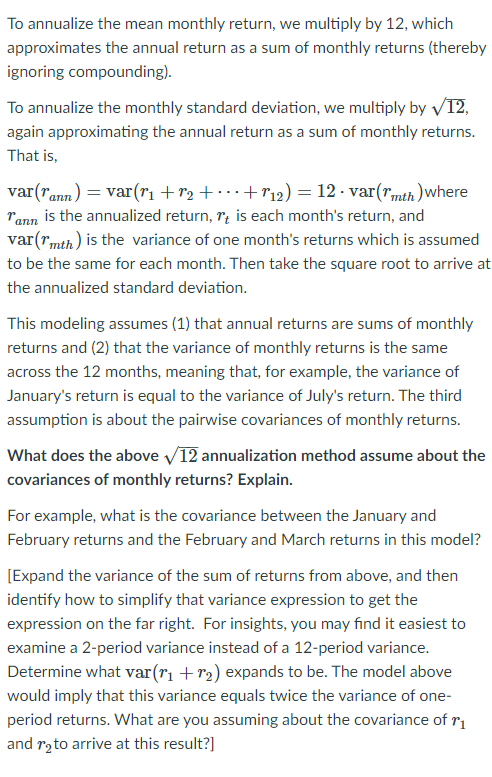
To annualize the mean monthly return, we multiply by 12, which approximates the annual return as a sum of monthly returns (thereby ignoring compounding). To annualize the monthly standard deviation, we multiply by 12, again approximating the annual return as a sum of monthly returns. That is, var(rann) = var(r1 +r2 + ... +r12) = 12 - var(mth) where rann is the annualized return, rt is each month's return, and var("mth) is the variance of one month's returns which is assumed to be the same for each month. Then take the square root to arrive at the annualized standard deviation. This modeling assumes (1) that annual returns are sums of monthly returns and (2) that the variance of monthly returns is the same across the 12 months, meaning that, for example, the variance of January's return is equal to the variance of July's return. The third assumption is about the pairwise covariances of monthly returns. What does the above 12 annualization method assume about the covariances of monthly returns? Explain. For example, what is the covariance between the January and February returns and the February and March returns in this model? [Expand the variance of the sum of returns from above, and then identify how to simplify that variance expression to get the expression on the far right. For insights, you may find it easiest to examine a 2-period variance instead of a 12-period variance. Determine what var(r +r2) expands to be. The model above would imply that this variance equals twice the variance of one- period returns. What are you assuming about the covariance of ri and rato arrive at this result?] To annualize the mean monthly return, we multiply by 12, which approximates the annual return as a sum of monthly returns (thereby ignoring compounding). To annualize the monthly standard deviation, we multiply by 12, again approximating the annual return as a sum of monthly returns. That is, var(rann) = var(r1 +r2 + ... +r12) = 12 - var(mth) where rann is the annualized return, rt is each month's return, and var("mth) is the variance of one month's returns which is assumed to be the same for each month. Then take the square root to arrive at the annualized standard deviation. This modeling assumes (1) that annual returns are sums of monthly returns and (2) that the variance of monthly returns is the same across the 12 months, meaning that, for example, the variance of January's return is equal to the variance of July's return. The third assumption is about the pairwise covariances of monthly returns. What does the above 12 annualization method assume about the covariances of monthly returns? Explain. For example, what is the covariance between the January and February returns and the February and March returns in this model? [Expand the variance of the sum of returns from above, and then identify how to simplify that variance expression to get the expression on the far right. For insights, you may find it easiest to examine a 2-period variance instead of a 12-period variance. Determine what var(r +r2) expands to be. The model above would imply that this variance equals twice the variance of one- period returns. What are you assuming about the covariance of ri and rato arrive at this result?]







